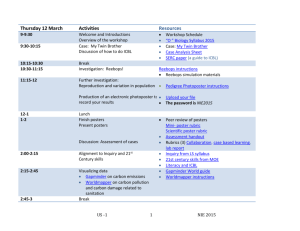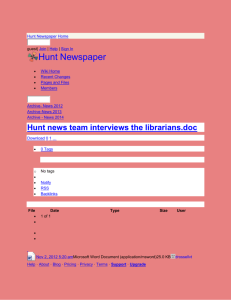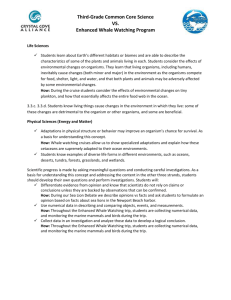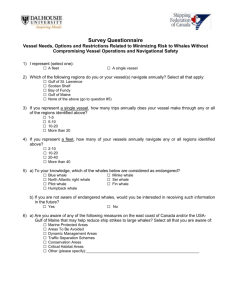Whale Hunt - University of New Mexico
advertisement
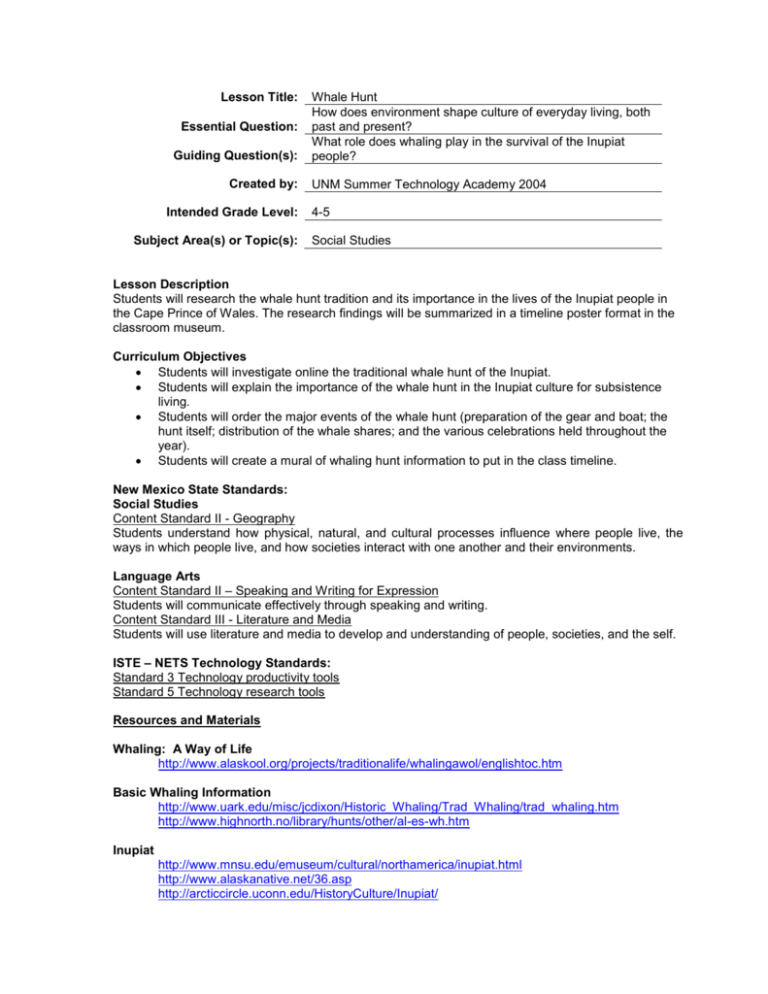
Lesson Title: Essential Question: Guiding Question(s): Created by: Intended Grade Level: Subject Area(s) or Topic(s): Whale Hunt How does environment shape culture of everyday living, both past and present? What role does whaling play in the survival of the Inupiat people? UNM Summer Technology Academy 2004 4-5 Social Studies Lesson Description Students will research the whale hunt tradition and its importance in the lives of the Inupiat people in the Cape Prince of Wales. The research findings will be summarized in a timeline poster format in the classroom museum. Curriculum Objectives Students will investigate online the traditional whale hunt of the Inupiat. Students will explain the importance of the whale hunt in the Inupiat culture for subsistence living. Students will order the major events of the whale hunt (preparation of the gear and boat; the hunt itself; distribution of the whale shares; and the various celebrations held throughout the year). Students will create a mural of whaling hunt information to put in the class timeline. New Mexico State Standards: Social Studies Content Standard II - Geography Students understand how physical, natural, and cultural processes influence where people live, the ways in which people live, and how societies interact with one another and their environments. Language Arts Content Standard II – Speaking and Writing for Expression Students will communicate effectively through speaking and writing. Content Standard III - Literature and Media Students will use literature and media to develop and understanding of people, societies, and the self. ISTE – NETS Technology Standards: Standard 3 Technology productivity tools Standard 5 Technology research tools Resources and Materials Whaling: A Way of Life http://www.alaskool.org/projects/traditionalife/whalingawol/englishtoc.htm Basic Whaling Information http://www.uark.edu/misc/jcdixon/Historic_Whaling/Trad_Whaling/trad_whaling.htm http://www.highnorth.no/library/hunts/other/al-es-wh.htm Inupiat http://www.mnsu.edu/emuseum/cultural/northamerica/inupiat.html http://www.alaskanative.net/36.asp http://arcticcircle.uconn.edu/HistoryCulture/Inupiat/ Umiak making http://www.skinboats.com/umiak.html Books Gift of the Whale The Inupiat Bowhead Hunt, A Sacred Tradition by Bill Hess (online reviews of the book give information as well). Can be purchased on Amazon.com. Other Materials Large Paper for mural. Pens/Markers/Colored Pencils/Paint Prerequisite Skills Students will need to know about the Inupiat people and how they live. Students will need to have basic Internet navigational skills. Process Anticipatory Set: After viewing the scrapbook “Tale of a Whale,” the teacher leads a discussion about the significance of whaling in the lives of the Inupiats. The teacher also conducts a read aloud with the book Gift of the Whale The Inupiat Bowhead Hunt, A sacred Tradition by Bill Hess in order to familiarize the students with a timeline of the whale hunt. They will also begin to understand how the whole social structure was dependent on the capture of a bowhead whale and the activities associated with the hunt. Students are separated into 5 groups. Each group will chose a portion of the whale hunt to research: Group 1) Preparation of the hunting gear and boat (umiak) Group 2) Hunting and capturing a whale Group 3) Responsibilities of the whaling captain, his wife and crew members Group 4) Distribution of the whale shares Group 5) Celebrations/festivals associated with the whale hunt throughout the year. Group 1 Students go to the “Whaling: a Way of Life” website to research and read stories about a whale hunt. http://www.alaskool.org/projects/traditionalife/whalingawol/englishtoc.htm Students compile information on the basics of preparing the hunting gear and boat. http://www.skinboats.com/umiak.html http://cronus.rockisland.com/~kyak/umicon.html Preparation information can include: steps of boat preparation and floats; paddles & oars, knives, spades, lances, hooks, bailers, harpoons, shoulder gun, and food. Group 2 Students go to the “Whaling: a Way of Life” website to research and read stories about a whale hunt. Students compile information about what happens during the actual whale hunt. Students describe the day of the hunt. This can include: the wife’s preparation in the morning and checking the equipment, establishing the whale camp, and chasing and capturing the whale. Group 3 Students go to the “Whaling: a Way of Life” website to research and read stories about a whale hunt. Students compile information about the importance of the captain and his wife, and the crewmembers. Group 4 Students go to the “Whaling: a Way of Life” website to research and read stories about a whale hunt. Students compile information about how the whale shares are distributed. Information can include: The alerting of the village, the very specific pieces of meat and who they go to, extra shares, new captain’s pieces, freeing the spirit of the whale, and storing the meat. Group 5 Students go to the “Whaling: a Way of Life” website to research and read stories about a whale hunt. Students compile information on the various celebrations held throughout the year for the whale hunt. Students should explain the following celebrations: Two afirruk feasts (fall & spring), messenger festival, qakummisaaliq (when a whale is captured) and one spring whaling festival nalukatak at the end of the season. The Inupiat people hold a deep respect for the whale and believe that its spirit can think and feel and talk. If they are respectful to the whale, its spirit will go back under the sea to report on the human behavior. Respectful behavior will result in a good whale hunt the following year. Additional information on feasts/festivals can be found at: Inupiat: (http://www.mnsu.edu/emuseum/cultural/northamerica/inupiat.html Inupiat of Arctic Alaska: http://arcticcircle.uconn.edu/HistoryCulture/Inupiat/ Eskimos: http://college.hmco.com/history/readerscomp/naind/html/na_011300_eskimo.htm Students will draw/color/paint a mural on paper depicting the portion of the whale hunt they were responsible for. The murals will be posted in order of occurrence. When the museum is open to other classrooms, students will act as museum docents and present information on the whale hunt to their museum visitors. Assessment Teacher-created rubric for the mural and oral presentations. Extensions / Modifications Students can use draw pictures on a computer using a Paint program Students can create a video slideshow depicting parts of the whale hunt.




